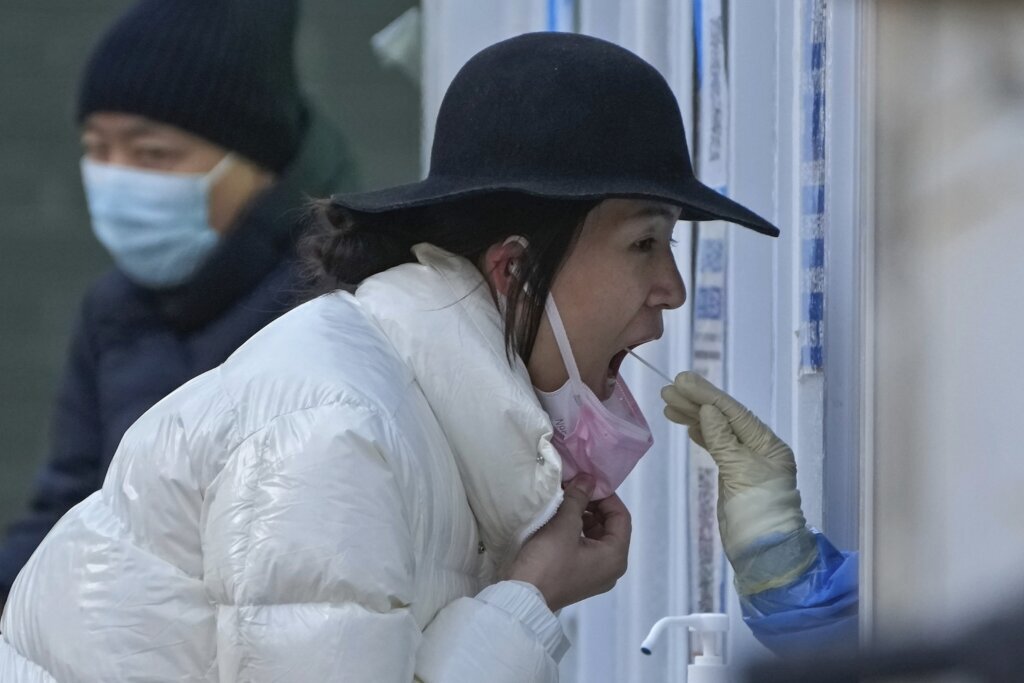
In a sharp reversal, China has announced a series of measures rolling back some of its most draconian anti-COVID-19 restrictions, including limiting harsh lockdowns and ordering schools without known infections to resume regular classes.
BEIJING (AP) — In a sharp reversal, China has announced a series of measures rolling back some of its most draconian anti-COVID-19 restrictions, including limiting harsh lockdowns and ordering schools without known infections to resume regular classes.
The National Health Commission in a 10-point announcement on Wednesday stipulated that COVID-19 tests and a clean bill of health displayed on a smartphone app would no longer be required, apart from vulnerable areas such as nurseries, elderly care facilities and schools. It also limited the scale of lockdown to individual apartment floors and buildings, rather than entire districts and neighborhoods.
People who test positive for the virus will be able to isolate at home rather than in overcrowded and unsanitary field hospitals, and schools where there have been no outbreaks must return to in-class teaching.
The announcement follows recent street protests in several cities over the strict “zero-COVID” policy now entering its fourth year, which has been blamed for upending ordinary life, travel and employment while dealing a harsh blow to the national economy.
China has sought to maintain the hardline policy while keeping the world’s second-largest economy humming, but public frustration with the restrictions appears to have finally swayed the opinion of officials who had championed “zero-COVID” as superior to the approach of foreign nations that have opened up in hopes of learning to live with the virus.
“Relevant departments in all localities must further improve their political positions … and resolutely correct the ‘one size fits all’ simplified approach,” the commission said in its statement posted on its website.
Officials, often those at the local level under intense pressure to prevent outbreaks, must “oppose and overcome formalism and bureaucracy, and take strict and detailed measures to protect people’s life safety and health to the greatest extent, and minimize the impact of the epidemic on economic and social development,” the statement said.
Newly reported cases of COVID-19 in China have fallen from a daily record of more than 40,000 in recent days to just 20,764 on Wednesday, the vast majority of them asymptomatic.
Under the new measures, lockdowns can last no longer than five days unless additional cases are discovered, restrictions will be lifted on the sale of cold medications, and vaccinations for the elderly will be stepped up.
Orders for businesses and transport companies to suspend services will be lifted and greater attention will be paid to public safety, with fire exits no longer blocked due to lockdown orders.
The recent protests included calls for leader Xi Jinping to step down. The protests began Nov. 25 after at least 10 people died in a fire in an apartment building in Urumqi in the northwest. Authorities denied suggestions that firefighters or victims were blocked by locked doors or other anti-virus controls. But the disaster became a focus for public frustration.
In its notice, the National Health Commission made no reference to the fire, the protests or any formal end to “zero-COVID,” which has been closely identified with Xi’s authority. The policy has kept most visitors out of China and disrupted manufacturing and global trade.
Officials for days have been gradually rolling back restrictions.
On Monday, commuters in Beijing and at least 16 other cities were allowed to board buses and subways without a virus test in the previous 48 hours for the first time in months.
Industrial centers including Guangzhou near Hong Kong have reopened markets and businesses and lifted most curbs on movement while keeping restrictions on neighborhoods with infections.
The government announced plans last week to vaccinate millions of people in their 70s and 80s, a condition for ending “zero-COVID” restrictions.
Health experts and economists warn it will be mid-2023 and possibly 2024 before vaccination rates are high enough and hospitals are prepared to handle a possible rash of infections.
Copyright
© 2022 The Associated Press. All rights reserved. This material may not be published, broadcast, written or redistributed.
Stay connected with us on social media platform for instant update click here to join our Twitter, & Facebook
We are now on Telegram. Click here to join our channel (@TechiUpdate) and stay updated with the latest Technology headlines.
For all the latest Health & Fitness News Click Here
